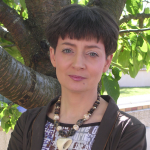Organic synthesis for biomedical research
Team Composition

Christine Gravier-Pelletier, DR
Permanent Staff
F. Berhal, MCU
M. Bosco, IE
P. Busca, MCU, HDR
S. Calvet-Vitale, MCU
L. Le Corre, IE
G. Prestat, PR1
M. Seremes, Tech.
T. Xavier, MCU
Post Docs & PhD Students
H. Esteves PhD 3rd year
J. Feng PhD 1st year
G. Lee PhD 2nd Year
H. Wan PhD 3rd year
The group’s expertise relies on multi-step synthesis of smart molecules for the chemistry-biology interface, methodology in organic synthesis and diversity oriented synthesis. Our objectives span from the development of new methodologies towards privileged structures in medicinal chemistry to the synthesis of enzymes inhibitors and molecular tools for biology. The designed methods are based on step and atom economy concepts and they notably involve domino reactions catalyzed by transition metals. We recently developed a green process based on the iron catalyzed generation of nitrene to perform the aziridination of alkenes. An unprecedented catalytic reductive cleavage of aromatic and heteroaromatic methyl ester functions was also successfully performed with a cheap, non-toxic, and air-stable Cu(OAc)2 catalyst. The diastereoselectivity of uridine-derived aldehyde 5’-alkynylation was investigated and revealed to be highly dependent on uridine protected groups. The synthesis of probes and molecules to study and inhibit enzymes involved in peptidoglycan biosynthesis machinery (MraY transferase, MurT/GatD amidotransferase complex) is a major objective of the group. No marketed drug is targeting these enzymes which are essential for bacteria viability, a key feature to tackle the issue of bacterial resistance to commonly used antibiotics. Complementary in silico approaches involving structure-based and ligand-based drug design are exploited. We are also developing new antiviral therapy to fight replication-cycle of HIV. Molecules resulting from our methodological developments were identified as novel classes of compounds interfering with the proliferation of the HIV with encouraging potency. These new tools will be used to discover and study new targets in the replication cycle of the HIV. Other on-going projects are dedicated to the design and synthesis of chemical tools for a better understanding of some pathologies such as Congenital Disorders of Glycosylation or Cystic Fibrosis. All the projects, at the interface between chemistry and biology, benefit from multi-disciplinary collaboration at the local, national and international levels. Major achievements can be reached thanks to the invaluable contribution of numerous motivated students and to the financial support of funding agencies (ANR, ANRS, VLM, FRM), they are gratefully acknowledged.
Organic synthesis for biomedical research
Team composition
Permanent Staff
F. Berhal, MCU
M. Bosco, IE
P. Busca, MCU, HDR
S. Calvet-Vitale, MCU
L. Le Corre, IE
G. Prestat, PR1
M. Seremes, Tech.
T. Xavier, MCU
Post Docs & PhD Students
H. Esteves PhD 3rd year
J. Feng PhD 1st year
G. Lee PhD 2nd Year
H. Wan PhD 3rd year
Team Description
Main publications
(click to see all publications)
Kirby, G.; Grimaud, L.; Vitale, M. R.; Prestat, G.; Berhal, F. Iron(II)-Catalyzed Intermolecular Aziridination of Alkenes Employing Hydroxylamine Derivatives as Clean Nitrene Sources. Green Chem. 2021, 23 (23), 9428–9432. https://doi.org/10.1039/D1GC03495B.
- Fichez, J.; Prestat, G.; Busca, P. Reductive cleavage of aromatic and heteroaromatic ester functions via Copper-catalyzed protodecarbo methoxylation. Org. Lett. 2018, 20, 2724-2727.
- Ben Othman, R.; Fer, M.; Le Corre, L. et al. Effect of uridine protecting groups on the diastereoselectivity of uridine-derived aldehyde 5′-alkyny lation. Beilstein J. Org. Chem. 2017, 13, 1533–1541.
- Fer, M.; Le Corre, L.; Pietrancosta, N. et al. Bacterial transferase MraY, a source of inspiration towards new antibiotics. Curr. Med. Chem. 2018, DOI: 10.2174/0929867325666180330095154
